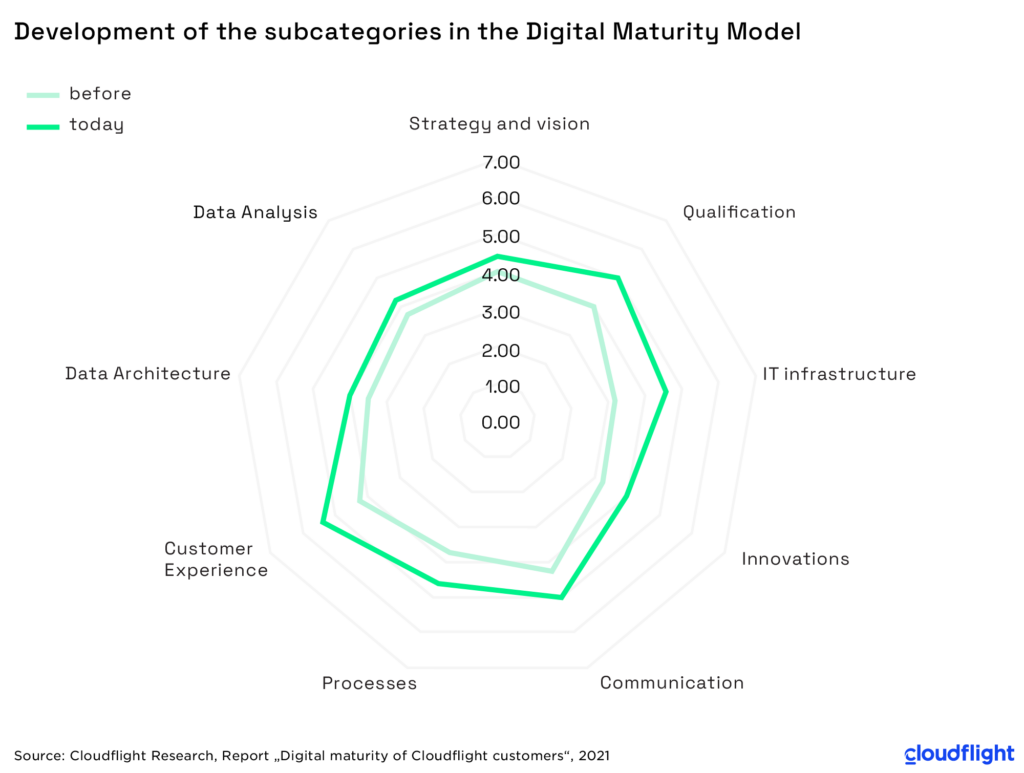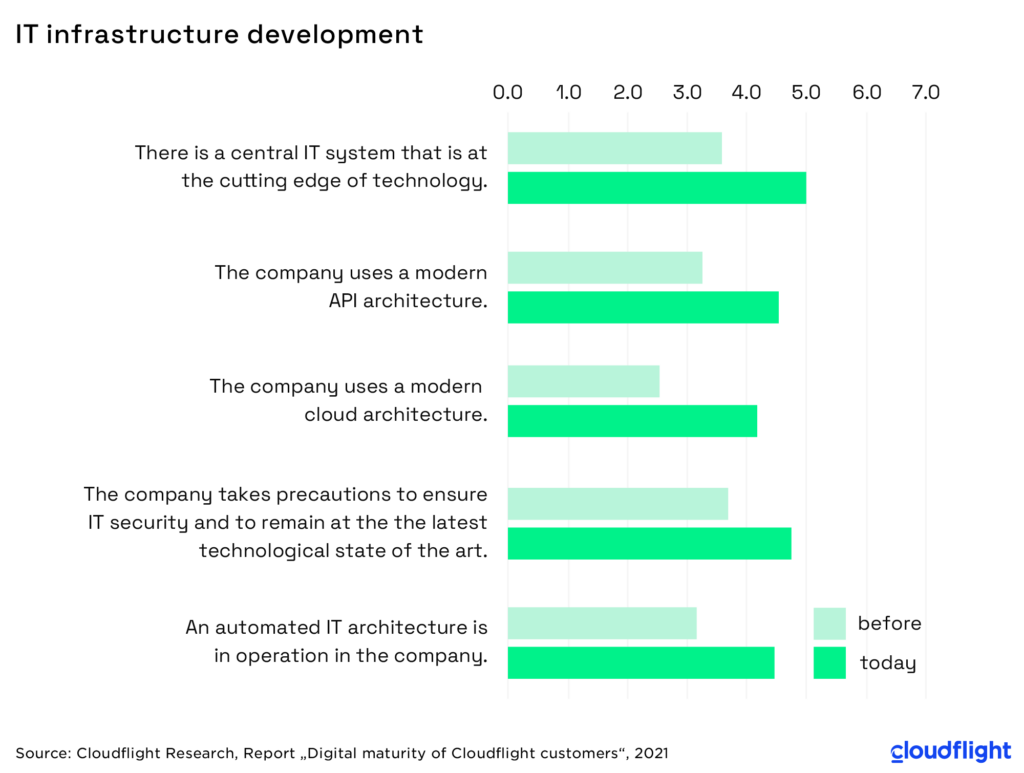Progress in stages, but it’s happening!
The business-critical importance of digitalization and all related measures in companies has become clear, especially in the last two years. Companies that pushed ahead with their digital resilience in terms of business continuity and business models at an early stage were able to go through the past months far more relaxed than those that still had to limit the damage until the very end. This has confirmed that digitalization has a high value and that, in addition to its enormous potential, it is essential for every company and state institutions.
But how well are the government and domestic companies really equipped for current and future “digital challenges”? A look at the development of digitalization in all EU countries shows that Austria is increasingly catching up. According to the European Commission’s Digital Economy and Society Index, which evaluates countries in terms of their progress in digitization, Austria has risen from 13th to 10th place in a Europe-wide comparison compared with the previous year. Germany also improved slightly, rising from 12th to 11th place.
In order to shed more light on this positive trend at company level, Cloudflight Research examined the digital progress of selected German and Austrian companies. The focus was on the progress in digitalization that has already been achieved and where there is still need for action or potential. This is intended to help corporate decision-makers better classify themselves and define, by comparison, what a suitable strategy for their company might look like.
It is crucial for companies to face the challenges posed by digital transformation and to constantly evolve to meet them. The Digital Maturity Model developed by Cloudflight Research makes it possible to evaluate companies with regard to their digital progress in terms of strategy and vision, technology, processes as well as data and thus gain insights into their development as well as open fields of action. All core areas of the company organization are included and it is shown which areas are already highly developed and which still have potential for improvement.
Digital progress of companies
The results of the study “Digital Maturity of Cloudflight Customers” show that all companies surveyed have consciously approached digital transformation and have thus been able to noticeably increase their digital maturity. They are already working on initiating the right actions to scale and holistically address digitization success. However, digitalization in these companies is still a long way from reaching its goal; there is still great potential, especially in exploiting the opportunities offered by new technologies. Many of the companies are still relying on proven technologies and processes, and only a few of them dare to be pioneers in the areas of Artificial Intelligence and Cloud, for example, and thus gain a decisive edge.
On average, the companies surveyed improved from “Digital Beginners” (level 2 out of 5) to “Digital Followers” (level 3 out of 5). If we look at the development in the individual dimensions, we see that the companies were able to improve in all categories on average. This is in line with the expected progression, as structures, processes and technologies are becoming established and these are constantly being developed further. In addition, companies are increasingly striving for economic advantages in competition through digitalization, which is now also attainable for medium-sized companies financially and in terms of technical possibilities.
The increase in qualifications and skills is primarily due to the deployment of IT experts in the companies. The companies surveyed also invested more in the further training of all other employees and thus also adapted their working methods to digitalization.
The IT infrastructure category evaluates the technologies and systems that enable IT operations. Here, companies have been able to improve considerably in recent years. The main reason for this is the increased introduction of cloud-native architectures (public and hybrid clouds). The existence of central IT systems and API architectures (integration & interface concept) was also partly responsible for the increases.
Increases have also been seen in the areas of innovation and data. However, there is still much greater potential here, especially in the area of analysis and use of data as well as Artificial Intelligence, because it can enable far-reaching increases in efficiency as well as the introduction of completely new business models.
Reasons for increasing the digital maturity level
There are many reasons for the positive development of the digital maturity level of the companies studied. Not only the implementation of individual software solutions, but also economic and social developments in recent years play a decisive role, as companies must adapt to changes in their environment in order to continue to be successful.
Especially when examining the technologies in the companies, it becomes apparent that the introduction of individual software solutions has a significant share in the increase of digital maturity. The development in the direction of cloud computing, cloud-native and microservices is among the most far-reaching progress and drivers of recent years. Due to highest flexibility, optimal scaling possibilities of computing power, storage and networks, more and more of the investigated companies rely on these technologies. In addition, the more software there is in a company, the more important it becomes to link the individual systems. With the help of a suitable API architecture, this is exactly what is possible, because applications and services can interact with each other regardless of their implementation.
In the companies studied, the willingness to invest in Artificial Intelligence and also to use it has increased significantly over the last few years. in this area help companies to optimize or even renew their processes. In many of the applications developed, elements of AI are already integrated, which can solve complex tasks or contribute to increasing (process) automation. Therefore, in addition to standalone solutions such as dedicated image and speech recognition, AI is increasingly becoming an integrated component in software solutions. It will therefore play an even more significant role in the digital transformation in the future.
In the area of qualifications and skills, clear increases were identified, especially in the use of IT experts. As the use and provision of applications increases, more experts are also needed. However, external experts are not the only ones responsible for development; companies are also increasingly looking to insource and train employees specifically in the development, maintenance and use of technologies in day-to-day business. This trend can also be clearly seen in the improved rating in the maturity model with regard to further training.
Especially through individually developed applications at the interface to the customer with new functions and user-friendly design, software projects can contribute significantly to increasing the customer experience. However, progress in this area is primarily due to general economic and social developments. The change in purchasing behavior towards direct and digital sales channels, due in part to the Corona pandemic, requires the introduction of eCommerce solutions for customers.
Necessary progress in all core areas
Digitalization is far from over and will continue to advance in the future. If companies want to continue to survive on the market in the long term, it is essential that they adapt to the digital transformation and implement changes. After all, competition is fiercer than ever before. Start-ups are emerging that are mapping business sectors completely digitally, and large companies are taking over parts of their value chains themselves. In addition, there is a danger that competitors will gain a digital edge and thus gain a competitive advantage. Therefore, companies need to continuously evolve in all core areas and adapt to the latest developments. However, digitalization should not be seen as a challenge, but rather as an opportunity to gain competitive advantages. Considerable potential is to be found above all in cloud computing, the use of data, and innovations.
Cloud computing forms the basis of the IT architectures of modern companies, both today and in the future. If companies want to develop further in terms of digitalization in the long term, a (hybrid) cloud strategy is essential. Companies should also rely more on cloud-native applications in the future in order to make optimal use of the advantages of the cloud.
Enormous amounts of data are in circulation in companies. In many cases, however, there is a lack of awareness of the value of this data and it is often used little or not at all. Proper preparation and analysis of the data brings an enormous potential that must be exploited. Companies that address this issue more intensively can achieve significant competitive advantages, because data provides the basis for improving business processes, enables precise predictions and can be the basis of new business models.
The willingness to invest in the latest technologies and business models is another key success factor for companies in the future. In this context, it will be necessary for innovations to become even more specific. However, for many companies, especially those still in the early stages of their digital development, catching up is also innovation. This is because for them, the introduction of new technologies, even if they are already considered standard, represents a great opportunity to increase the level of digitalization in the company. The topic of AI in particular has enormous potential, which many companies have recognized but not yet exploited. AI makes it possible to increase the efficiency and automation of processes and can also enable new business models.
In conclusion, it remains to be said that successful companies should face up to the digital transformation and actively use it. In drastic terms, companies that miss this opportunity will sooner or later disappear from the market.
If you want to know more, you can download Cloudflight Research’s “Digital Maturity of Cloudflight Customers” report here.

